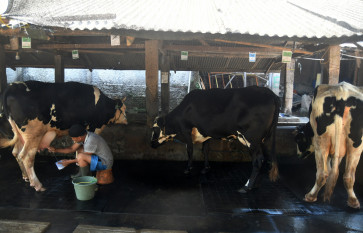Popular Reads
Top Results
Can't find what you're looking for?
View all search resultsPopular Reads
Top Results
Can't find what you're looking for?
View all search resultsMaking Betawi food great again
Halal drinks: A seller displays bir pletok (spice-based Betawi beverage) at Setu Babakan Visitors Center in South Jakarta
Change text size
Gift Premium Articles
to Anyone
H
alal drinks: A seller displays bir pletok (spice-based Betawi beverage) at Setu Babakan Visitors Center in South Jakarta. The beverage is non-alcoholic and its ingredients are completely different from that of a common beer. (JP/Riska Rahman)
As most contemporary inhabitants of Jakarta would probably say, indigenous Betawi cuisine can be readily summed up in three dishes: kerak telor (spicy omelette from glutinous rice with fried shredded coconut), nasi uduk (steamed rice cooked in coconut milk with side dishes) and soto Betawi (Betawi beef soup).
That was what Sutrasno, a Jakartan for almost 60 years, thought. At least until he and his wife stopped by an old house-turned-restaurant called Rumah Makan H. Nasun in Jagakarsa, South Jakarta, one bright Sunday.
The middle-aged couple ordered pecak gurame (freshwater carp served with H. Nasun’s take on traditional pecak sauce), to which he added coconut milk into the usual mix of ground chili, ginger, turmeric and great galingale. The late cook, founder and namesake of the traditional Betawi restaurant, then topped his signature dish off with freshly squeezed lime juice and a generous amount of fried shallots. This intricate combination of ingredients results in a surprisingly provocative aroma.
“We also ordered gabus pucung, but unfortunately they had run out of gabus (snakehead fish), so we asked the cook to pour the pucung sauce over a gurame instead,” Sutrasno told The Jakarta Post.
The pucung seed, more commonly known as kluwek, is usually associated with beef, as it is the main ingredient of rawon (stewed beef). This particular seasoning, which gives the dish its signature dark brown hue, piqued the couple’s interest.
Their lack of knowledge regarding lesser-known traditional Betawi dishes, which take their name from the indigenous people of Sunda Kelapa, a coastal area of the region renamed by the Dutch colonial forces to Batavia (or Betawi in local dialect), reflects modern Jakarta’s collective obliviousness to culinary heritage.
Betawi cuisine is brimming with such delicacies as bubur ase (rice porridge topped with pickled mustard greens and bean sprouts in semur, sweet black beef stew) and traditional desserts such as kue dongkal (cone-shaped sweet cake made with ground rice, coconut and palm sugar).
In modern metropolitan Jakarta, these types of food cannot compete with the popularity of sushi, Italian pasta and even Central Java’s gudeg, West Sumatra’s rendang and the trendy ayam geprek, and Betawi dishes may be on the verge of culinary extinction.
According to Rumah Makan H. Nasun’s waitress and cook, Henny, this trend is due to the difficulty in preparing the traditional dishes themselves.
“Very few people are able to make good pucung. The delicate balance between sweet and savory is tricky to pull off,” Henny said.
Betawi historian JJ Rizal views the phenomenon as a direct consequence of the drastic change in Jakarta’s ecosystem.
“Asphalt and concrete have overtaken swamps, the natural habitat of the snakehead fish,” he told The Jakarta Post. “Therefore, both the environmental and cultural ecosystems that support gabus pucung have now vanished.”
Bang Lopi, the owner of a bubur ase stall in Gandaria Market on Jl. Kebon Kacang II, Tanah Abang, Central Jakarta, blamed the decreasing fame of this sweet and salty Jakarta breakfast food on the rising popularity of bubur ayam (chicken porridge).
NUSA Gastronomy owner and head chef Ragil Imam Wibowo is of the opinion that the native Betawi’s exodus to outer parts of the city has made these traditional delicacies hard to find.
“Traditional cuisine follows where the cultural tribe goes,” Ragil said. “The native Betawi, who used to populate the center of the city, are now scattered all over the city’s fringes; so modern Jakarta is estranged from its own culinary heritage.”
Granted, it’s not all doom and gloom when it comes to the preservation of Betawi cuisine. Modern Betawi restaurants, such as Kafe Betawi, have set up shop in upscale shopping malls like Pacific Place and Grand Indonesia to satisfy local demand for the best known Betawi dishes.
That said, there is still an entire range of traditional Betawi delicacies — gabus pucung and pecak gurame, for instance — that are still yet to be discovered by modern Jakartans.
“The fact that Jakarta has become a melting pot of various cultures forces the native Betawi to sell the already popular dishes,” Indonesian culinary expert William Wongso explained. “They fear that selling lesser-known dishes would make their businesses less profitable.”
In fact, there is still much more to Betawi’s culinary heritage than those popular foods because the cuisine is an essential part of their traditions.
“Rituals like weddings, for example, must include roti buaya [crocodile-shaped bread],” JJ added. “It symbolizes that the couple can only be separated by death.”
Being a port city, Jakarta was heavily influenced by Chinese, Dutch and Arab migrants. This eclectic mixture of cultural influences enriched the flavors of traditional Betawi cuisine.
Sadly, JJ lamented that neither the local nor central government have done enough toward preserving the Betawi culinary heritage. “There are no concrete, sustainable plans to save it from extinction.”
On a more positive note, however, the Jakarta Tourism and Cultural Agency has gathered several producers of traditional Betawi snacks, such as the dodol (sticky candy) and bir pletok (traditional non-alcoholic spice-based beverage) in Setu Babakan, Jagakarsa, South Jakarta.
“We’ve always tried to involve these home industries in many of our culinary and cultural festivals so they can showcase and re-introduce the Betawi culinary heritage to the modern public,” head of the Jakarta Tourism and Cultural Agency Tinia Budiati said.
According to chef Ragil, another way to re-introduce traditional Betawi cuisine to the mainstream would be to update the presentations of the dishes themselves.
“Dishes like bubur ase, for example, look antiquated and put off many young people,” Ragil said. “So we try to modernize their looks and taste in NUSA Gastronomy without compromising the cultural history.”
_______________________________________________
Writing in-depth articles is part of a two-month training program for young journalists of The Jakarta Post. Ana Cecilia Regalado, Istu Septania, Norman Harsono, Riska Rakman, Rizky Fachriansyah Aziz and Susan Atika Maesara recently conducted interviews and research for the Reportage issue in today’s paper.










